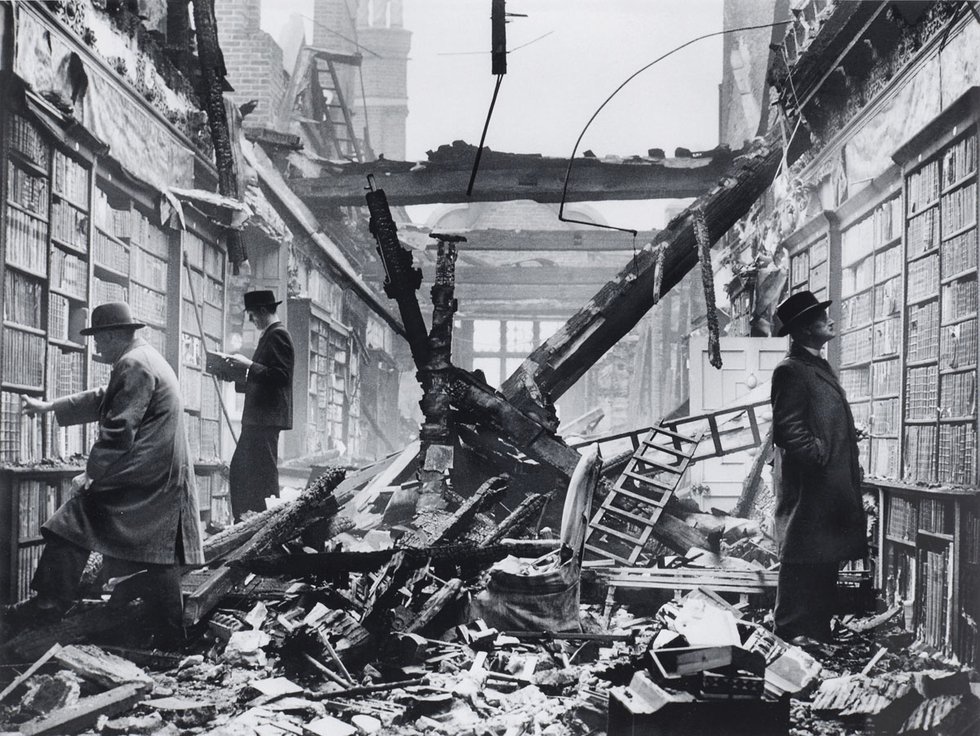Handful of Dust
An international photography show offers a speculative history of the last century using dust as a linking theme.

Photographer unknown, Holland House library, Kensington, London, after an air raid, 1940
A Handful of Dust: from the Cosmic to the Domestic is a meditative photography exhibition that has toured from London, Paris and New York to the Polygon Gallery in North Vancouver. A speculative history of the last century organized by the British writer and curator David Campany, it uses the unlikely topic of dust as a focal point, particularly in response to Man Ray’s 1920 photograph Dust Breeding.
Displayed as an enlarged print in the gallery, Man Ray's image documents a Marcel Duchamp work on a pane of glass that would come to be known as The Bride Stripped Bare by Her Bachelors, Even. An arrangement of lead foil and fuse wire, it was covered in a thick layer of dust when Man Ray saw it in Duchamp's New York studio. Two years later, Man Ray published the image in an avant-garde French journal with a deliberately misleading caption, View from an aeroplane, blurring the distinction between artifice and reality.
A Handful of Dust, which includes everything from images of the American Dust Bowl to the wars in Iraq, allows Campany to ruminate on documentation in an expanded form. Is it an archive? Is it art? Is it a performance? He uses the presence of dust as a creative tool to parse these questions.

Scott McFarland, “Lens Cleaning Schneider APO-Symmar5.6/180MM” James Perse Space Crewneck Jersey T-shirt, 2017
chromogenic print, studio dust displayed in custom colour frame, 25” x 20”
In some works, dust manifests in a physical way. For instance, Toronto-based Scott McFarland’s series of chromogenic prints, Lens Cleaning Schneider Apo-Symmar 5.6/180MM (2017), shows clusters of dust gathered between print and frame.
Meanwhile, American artist John Divola’s Vandalism portfolio (1974-75) is a series of close-up black-and-white images of spray-painted walls and other surfaces that he created in abandoned houses.
Campany also includes traditional approaches to photography. He displays a mix of anonymous postcards, press photos and magazine spreads, alongside works such as American Jeff Mermelstein’s Statue (‘Double Check’ by Seward Johnson), New York, 11 September 2001, which examines dust as a participant in historical events such as 9/11. In this context, dust is a consequence of destruction.

Jeff Mermelstein, “Statue (‘Double Check’ by Seward Johnson), New York, 11 September 2001,” 2001
chromogenic print
The range of the show, as the title suggests, is broad. Indeed, participating French artist Sophie Ristelhueber writes: “The constant shift between the infinitely big and the infinitely small may disorientate the spectator. But it is a good illustration of our relationship to the world: we have at our disposal modern techniques for seeing everything, apprehending everything, yet we see nothing.”
Campany, by linking diverse works through their relationship to dust, speaks to the ambiguities of photography. Ultimately, he leaves the making of meaning up to viewers by posing questions and leaving space for many possible responses.
A Handful of Dust: from the Cosmic to the Domestic is on view at the Polygon Gallery in North Vancouver from Feb. 8 to April 28, 2019.

The Polygon Gallery
101 Carrie Cates Court, North Vancouver, British Columbia V7M 3J4
Wed to Sun 10 am - 5 pm, Thurs until 8 pm
